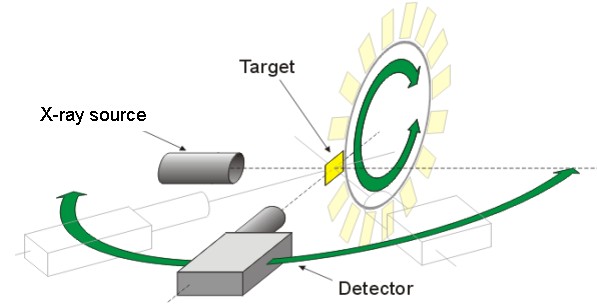Introduction
X-ray fluorescence is a technique that can be used to determine the surface composition of a sample non-destructively. Related to this technique are various processes such as attenuation of x-rays in materials, absorption, fluorescence yields, coherent and incoherent scattering.
In this experiment some of these processes can be studied using a 241Am source.
Theoretical Background
Absorption of x-ray photons by a target can be described by the law of Lambert-Beer. After absorption a part of the energy can be released through emission of fluorescence photons. Relevant topics are electron states (K, L, M), characteristic lines, selection rules, fluorescence and intensity yield, absorption and scattering of x-rays.
Experimentation Method
Absorption measurements can be performed if a target is placed between a radioactive source and an x-ray detector. For targets specific materials with different thicknesses can be selected. Fluorescence measurements can be made if the x-ray detector is placed in such a position that the radioactive source and the detector both point to the same surface area of the investigated target. Energy spectra of detected x-ray photons can be recorded.
Motivation to perform this experiment remotely
Because of the use of the radioactive source in this experiment it is for the student safer to do this experiment at a distance. Institutes who will use this experiment will not be bothered with the safety requirements and license requirements to store this radioactive source.
Setup
Short description
For the x-ray production a 241Am source is used. The detector is automatically set in the correct position when absorption or fluorescence measurement is chosen. Targets of different materials and various thicknesses are placed in a carrousel. A specific target can be chosen by rotating the carrousel. The energies of the detected x-ray photons are measured and stored in a Multi Channel Analyzer (MCA) to produce an energy spectrum. Energy spectra from known materials can be used to calibrate the Multi Channel Analyzer.
In principle it is possible that students send their own targets to investigate.
Schematic view

Remote Interface
Variables that can be controlled remotely
- Position of the x-ray detector for absorption- or fluorescence-measurements.
- The carrousel to choose a specific target.
- Parameters of the data acquisition system.
Variables that can be measured remotely
- The x-ray energy
- The position of the x-ray detector
What is visualized remotely?
- The measured spectrum
- Measuring parameters of the Multi Channel Analyzer (gain, number of channels and measuring time).
- The position of the x-ray detector (web cam).
- An overall view of the setup of the carrousel with the materials and radioactive 241Am source
Educational
Learning Objectives
- Determine data acquisition parameters to optimize the experiment.
- Calibrate a measuring system.
- Interpret measured spectra.
Target Group
- Bachelor students in physics
- Bachelor students in natural medical science
- Bachelor students in earth science
Professional Relevance
- A technique to determine the surface composition of a sample non-destructively.